Common milkweed shoots are one of the best parts of the plant, with a couple caveats.
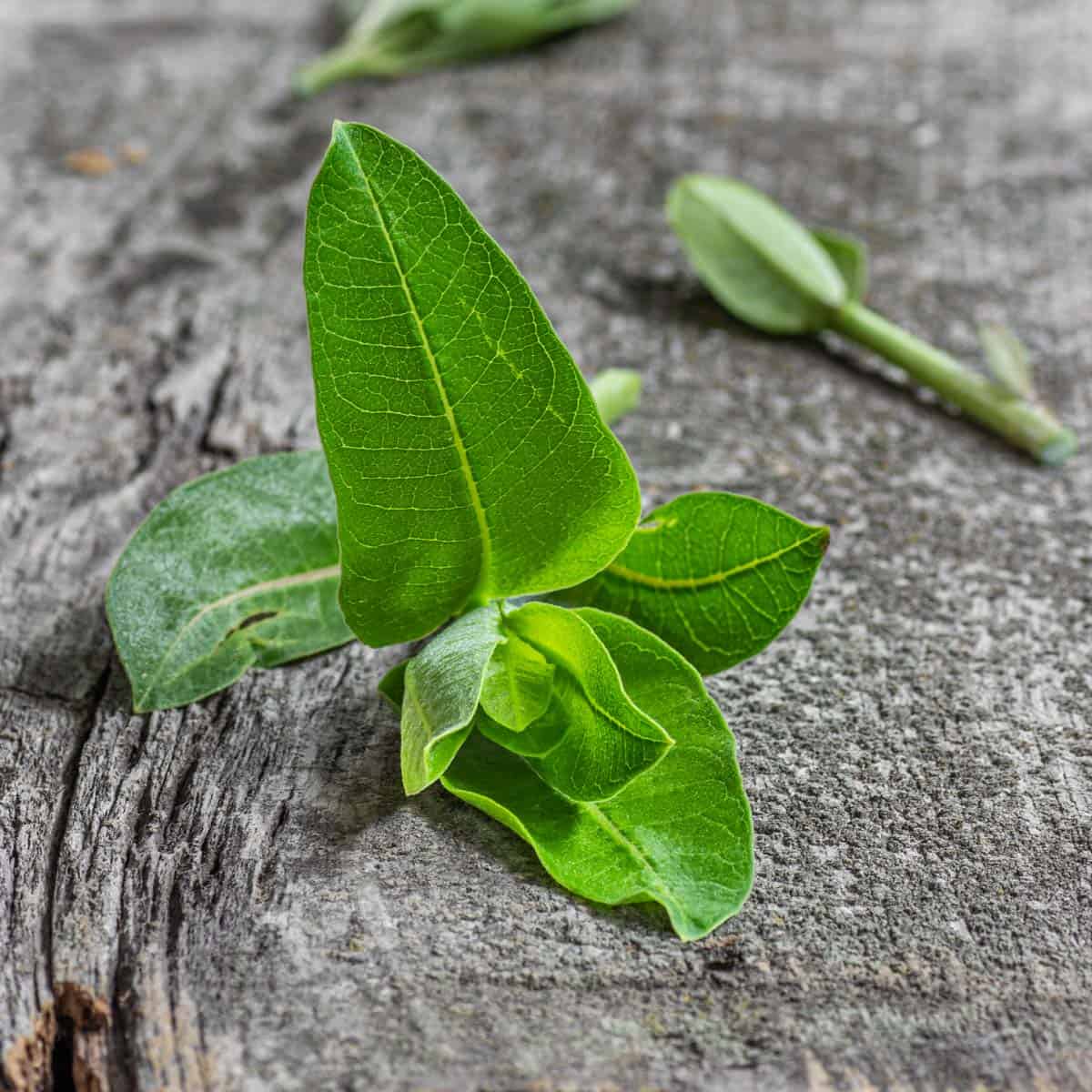
Note: This post only covers the edible shoots of common milkweed. For a full breakdown on every edible part of the plant I know, please refer to my Guide to Milkweed.
At the restaurant we've been obsessed with milkweed shoots lately (the shoots of Asclepias syriaca, or common milkweed). They're awesome because they help to fill the gap of what to hunt for in the month or so of "interim" we have until the chanterelles start, but these pretty guys are much more than a consolation prize.
Finding wild plants that are edible isn't hard, but finding some that are truly delicious is. The Milkweed and all of it's gifts are really one of the greatest things I have discovered so far, and I have eminent forager Sam Thayer to thank for it.
I first read about harvesting the shoots of milkweed in Thayer's book The Forager's Harvest, which is a great resource for us in Minnesota since Thayer is Based in Wisconsin. There is not a lot of literature on Midwest wild food and most of it is outdated, regurgitated field guide info, so Thayer's book is a real treasure.
Back to the milkweed shoots. These are great because they're not only widely available, but delicious. It can be tough to find wild plants that lack bitterness, so milkweed really stands apart. When the shoots are young, the stem is tender and juicy, not even close to bitter like some people say. Here is the kicker, and Sam covers this in his book: there is a bitter look alike species called dogbane.
It can be tricky to separate common milkweed from dogbane, and I made the mistake once of making a soup with dogabane shoots instead of milkweed, it was incredibly bitter. Both plants like to frequent the same areas, and unfortunately, both give off white latex when the stem is broken.
The two plants differ in that dogbane's stem is much more firm, also it's leaves are more pointed, and they are more thin than the fluffy, slightly furry leaves of milkweed. Dogbane leaves are also very smooth to the touch, where milkweed leaves are a bit fuzzy feeling, like sage. I just taste tiny bits of the stem in the field, it's not hard to pick out the biter from the real deal.
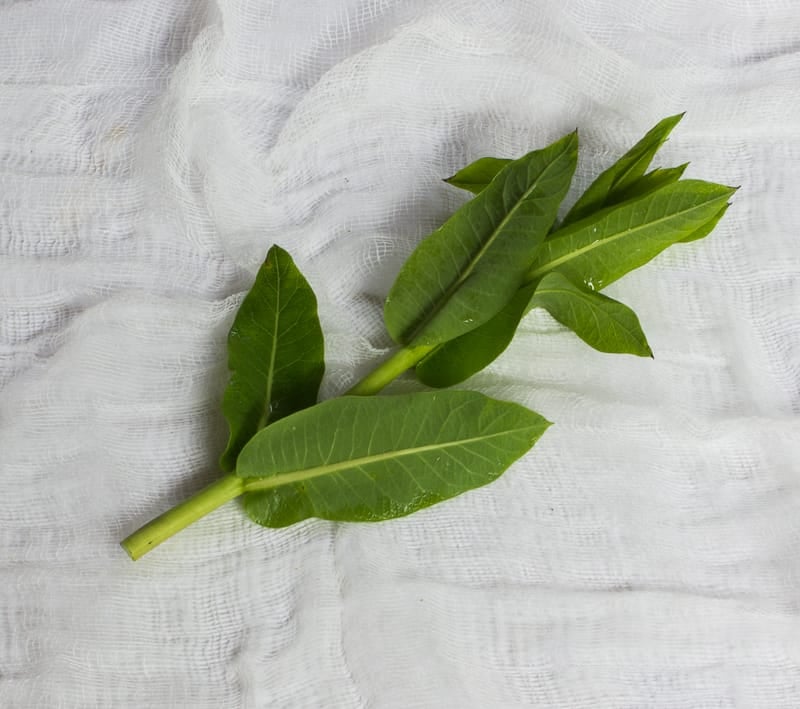
If the sweet shoots weren't cool enough, after the stems start to get fibrous, the milkweed continues to change. Already I can see my favorite part of the plant starting to show itself: the buds. Like broccoli from an alternate dimension, they're excellent, and have every bit of the sweet character that the shoots do, if not more.
Overindulgence
Just a quick note before you embark on a milkweed adventure. Overconsumption of milkweed, for some people, can lead to some GI problems. Start off small, say a couple shoots, or an ounce, see how your stomach feels, and take it from there.
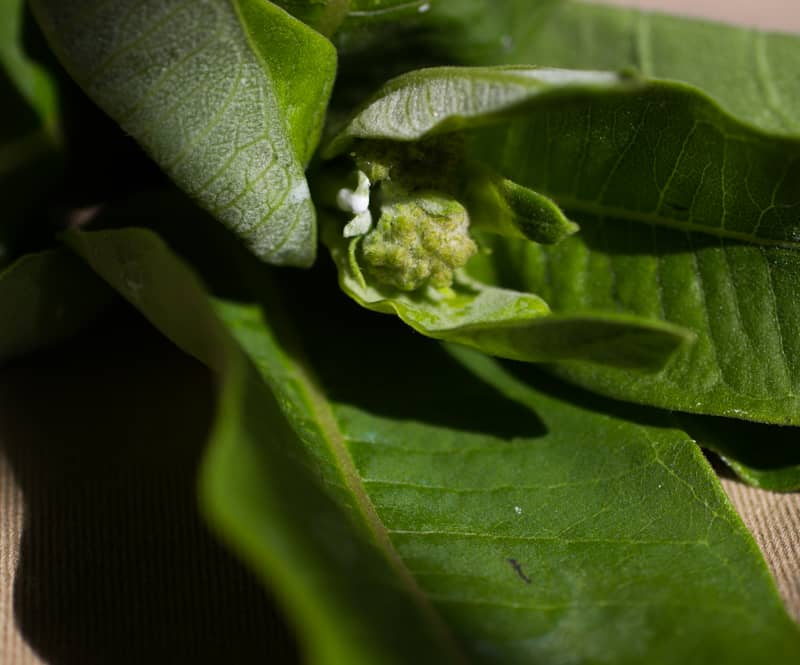
Cooking Milkweed Shoots
Here is some general culinary knowledge I've gleaned from working with them:
- Blanch your milkweed in salted water before frying to ensure it's tender.
- Do not over-indulge, especially if it's your first time. Eat a few shoots first to make sure they agree with you, as everyone's digestive system is different. Over indulgence can make some people sick, even if it's well-cooked.
- To find where the milkweed is tender while picking, break it off where it breaks clean, just like you would asparagus.
- I like to remove the large leaves from milkweed when I'm going to eat the stem, up until the very top leaves. The leaves you trim off can be cooked separately, if you like, I suggest chopping them, then braising until they're soft and tender.
- Milkweed loves fat, it's hard to explain, but the leaves have a tendency to taste "dry", imagine eating cooked sage leaves. Butter, oil, vinaigrette, lard, use whatever you want, just keep it lubed-up and it will be delicious.
- The leftover leaves from trimming milkweed can be braised until soft, or pureed to color pasta, like I do in this recipe.
Milkweed Shoots
Ingredients
- Young tender milkweed shoots, broken off where they're tender, like asparagus
- Kosher salt for the blanching water, plus more to taste
- Water
- Unsalted butter to taste, or another fat you
Instructions
- Bring a pot of salted water to a boil, it should taste like the sea. Meanwhile, remove the leaves from the milkweed shoots until you reach the top cluster of small leaves, if you end up liking the texture of the leaves, you can leave more on, but I suggest trying them with only the top-most leaves on at first as they'll be the most tender.
- Blanch the milkweed shoots for 30 seconds, then transfer to a pan with butter if you'd like to fry or saute them with other ingredients.
- If you want to put the milkweed shoots directly on a plate, and say, top them with salt and butter, cook them for a bit longer, say 1 minute or so, or until a cooked shoot tastes good to you. The milkweed shoots should not be mushy--just imagine you're cooking asparagus.
Notes
Milkweed Can Regrow It's Shoots and Buds
As a final note, I almost get scared putting up posts on eating milkweed, people are really fiesty when it comes to this plant, and the harm they assume comes to the monarchs from people harvesting it. In my world, and in the world of a number of other well known foragers, the opposite is true.
Enjoying cooking with milkweed means I want more of it, and I'm not going to do anything to mess up a good patch. Additionally, the heading is true...milkweed can regrow shoots after harvesting, it also reproduces underground via rhizomes, as well as above ground with seeds. So here is your evidence for people that would shame you for enjoying this plant.
It should be noted that I haven't tested this in wild areas where I harvest, only places where a lawn mower on the farm can pass through. Either way, it's step in the right direction for milkweed harvesters.
More
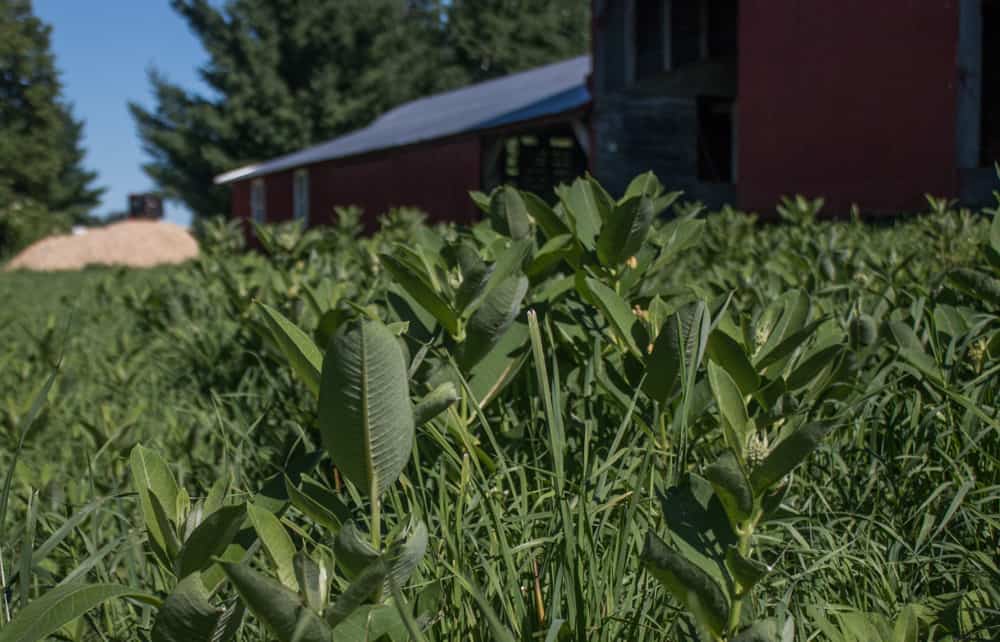

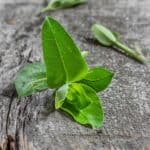
Laura Bearskin
We all enjoy milkweed bud soup. Thank you for sharing additional recipes. We've planted them all over the yard and in our "gardens" - there's PLENTY for us and for the butterflies. Delicious!
Susan Goldhor
As a muchroom hunter I'm a big fan of your website, and recommend it to all the mushroomers I know. While checking out your chicken of the woods recipes, I saw the delicious looking milkweed shoots and, since I had quite a few that had escaped from the meadow to the lawn, I picked some and sauteed them in butter. They were delicious! But, since then, I've started to worry a little about the cardiac glycosides in milkweed. It is a toxic plant. Is this something we should be worried about and readers should be warned about? I'd appreciate your thoughts on this.
And thank you for your beautiful and useful blog!
Alan Bergo
Hi Susan.
Good question. The answer might seem a little odd. The quick answer is that milkweed is a safe, delicious food. The longer answer is this: many things we eat have nutritional, medicinal, or even toxic sides to them. Morels for example, are also toxic (far more than milkweed IMO) as is nutmeg and cassia cinnamon. Some “modern” science would also say bacon is a carcinogen. When I consider the edible properties of any food, I do take into account modern information, but even more importantly, I balance it with ethnobotanical evidence of consumption. When I come across alarming info like dangerous glycosides found in milkweed, I find it helpful to ask myself: in what way are these compounds harmful to humans? Raw? Is the plant toxic after cooking or boiling? From there, if it’s indeed dangerous, why would indigenous populations have eaten it? In the case of vetch/Vicia americana, which most online resources erroneously labor as toxic or even lethal, the plant is well documented as an edible by indigenous populations (just like milkeeed) and the dangerous aspects of it should be strictly labeled for grazing ruminants only, even then the plant is probably safe and even good for them in modest amounts. With milkweed, the only thing to keep in mind for safety in my opinion is that it should be cooked before eating, and some people may need to have it boiled first. Raw, it could be toxic, sure, just like all Morchella and Gyromitra.
Randy Buker
I tried them for the first time tonight. I sauteed them in olive oil and butter, lightly seasoned them with garlic and onion. The plants I harvested today were only about ten inches tall and looked like they'd be perfect. But, they ended up being a bit tough and stringy.
I wonder about par boiling them first to tenderize them?
Alan Bergo
I'm sorry, I think my post was not as direct as far as cooking these goes. I always blanch milkweed shoots before cooking, 30 seconds for a par-boil is fine, if you want them to go straight to the plate, just cook them until they're tender, and taste good to you, like asparagus.
Ann
Give botanical names of plants, please... common names vary, scientific names necessary to avoid confusion...
Alan Bergo
I added that in there: it's Asclepias syriaca, and it's the only edible milkweed I know of besides poke milkweed (A. exaltata).
HANNAH HELM
I am delighted to read this. I have been eating milkweed buds for almost 30 yrs, but I was taught you had to cook them in 3 changes of boiling water, a real pain. According to this I don't have to go to all that trouble and I'm missing out of lots of other great eating. I'm headed out shortly to see if I can find some young enough for silk. I love this. I have a garden, but I live on 50 wooded acres and much prefer foraging. I can't believe all the plants I've been passing by all these years!
Alan Bergo
Good for you Hannah. Milkweed is such an under-appreciated edible. I've been coating the young pods in cornmeal and loving them this year. There is so much food out there: enjoy.
HANNAH HELM
As a southern girl, I live things battered with cornmeal. I've got to try this. Sadly my milkweed is too old for this year, but I'll be prepared next. I love your blog and look forward to trying new intersting edibles. FYI-Have you tried pokeberrues. Most think they are poisonous. I haven't researched whether it's cooking them or removing the seeds but an old local firager of the Eull I'll gave me a recipe for pudding and it's pretty good.
sam schaperow
https://foragerchef.com/wp-content/uploads/2014/06/Milkweed-shoots_-2.jpg looks like milkweed to me. Maybe that one bitter species discussed from time to time, but I don't see the redishness of dogsbane, the thinness of it, etc. I do realize the leaves may be covering some of the latter characteristic, and the resolution doesn't let me see the fuzz found in milkweed.
Dan Farmer
I found some very nice ones today, nearly at the "broccoli" stage. I only too seven of the tips... I hope the monarchs won't mind... and boiled them in salted water for a couple of minutes while I prepared a simple vinaigrette using the juice from some pickled ramps, a bit of mustard, and some grape seed oil.
I was in heaven! They were even better than my first attempt. I am going to be looking forward to milkweed season from now on!
Sam
Dan, "in heaven" is some high praise. TY for sharing what you did w/them.
BTW, have we interacted before outside of here? I feel like we have, but maybe I'm thinking of another farmer.
Lois
Wow, those are EDIBLE? Never knew!! I thought they were poisonous all these years since all I know that eats them are the Monarchs, and not much eats them! Keep it coming Alan, I am really starting to notice all those weeds I never knew we could eat! It all started with wondering about mushrooms, now I'm learning trees, plants, and how to prepare them all because of you fine folks that are willing to try new things! Well, I'm in the same category, I just can't make it taste as good as you do!
Sam
1. What species is the bitter one?
2. Diane, perhaps you'd enjoy growing them deliberately both for you to eat and add more for the butterflies?
3. Alan, unlike, say red sorrel, I find that these get more vibrant when boiled. Have you ever found them to not? If not, then I'd think the blanch & shock method isn't needed for that purpose.
Sam Schaperow, M.S.
http://tech.groups.yahoo.com/group/PlantForagers
http://tech.groups.yahoo.com/group/MushroomTalk
Alan Bergo
Hey Sam! Blanching the milkweed makes it vibrant, absolutely. It will lost the enhanced green if it isn't chilled afterwords, but it's not too noticeable. The blanching technique locks in the color but it also halts overcooking. If I need to have the milkweed ready in a flash at the restaurant, I may par blanch in sat water and shock in an ice bath, but most times I will just boil it in salt water "a la minute". The shocking and blanching is useful for freezing though.
Sam
Hi Alan:
I can imagine the shocking will take care of protecting the color, but have you tried just boiling them (beyond the short blanching time)? I mean, boiling even until fully cooked will keep the vibrant color, last I remembered. Anyway, I'm glad you mentioned Sam Thayer's book. Perhaps he'd know the species you found. You or I can send him the pictures you have (do you have more of the bitter one?).
Lois, tons of stuff out there is edible. Even the young leaves of Norway Maple, which can have some bitter, but also some acid in their flavor. Or, the shoots and leaves of Tree of Heaven, which does have bitter, but also a unique and odd flavor. I'd like to see what Alan would do w/that flavor. Also, as I just posted to a mushroom group, I just experienced a Xylaria mushroom that has a buttery flavor (not texture) when eaten raw, which is not ordinarily known to be edible. The butteryness is ridiculous. I keep shaking my head in amazement when I eat it. So crazy incredible, no?
Sam Schaperow, M.S.
http://tech.groups.yahoo.com/group/PlantForagers
http://tech.groups.yahoo.com/group/MushroomTalk
Lois
Wow, tried the milkweed this evening, sautéed it with butter & added a little seasoning and it was wonderful!!! Thanks to you guys!! Keep the great weeds coming, I'm excited to learn more that is not only free but healthy out there!
Alan Bergo
Glad you liked the milkweed Lois, The buds are out now too, make sure to try them, they're super tasty.
Diane
My concern about milkweed is that it is the main source of sustenance for the Monarch
Butterfly that is endangered!
Anne Cheng
We always boiled them, then added a touch of red wine vinegar when served.
Alan Bergo
Sounds like a great way to have them.